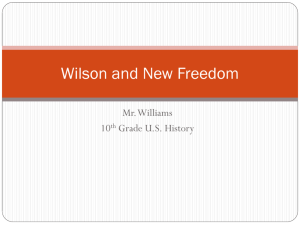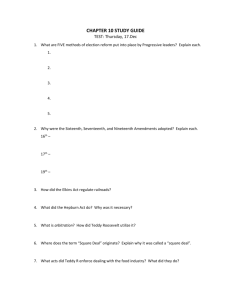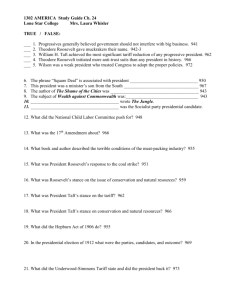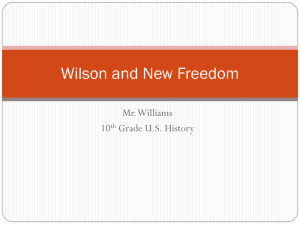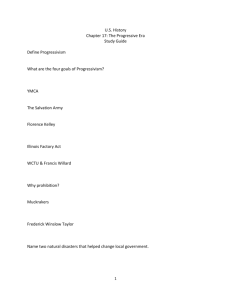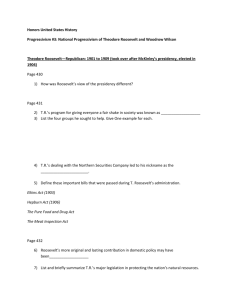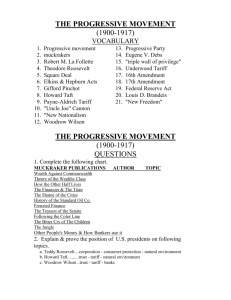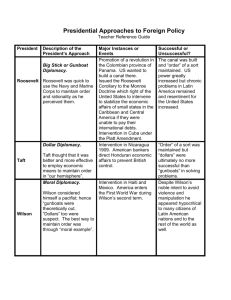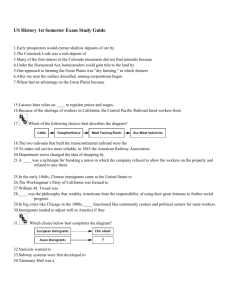Chapter 24: The Progressive Era
advertisement
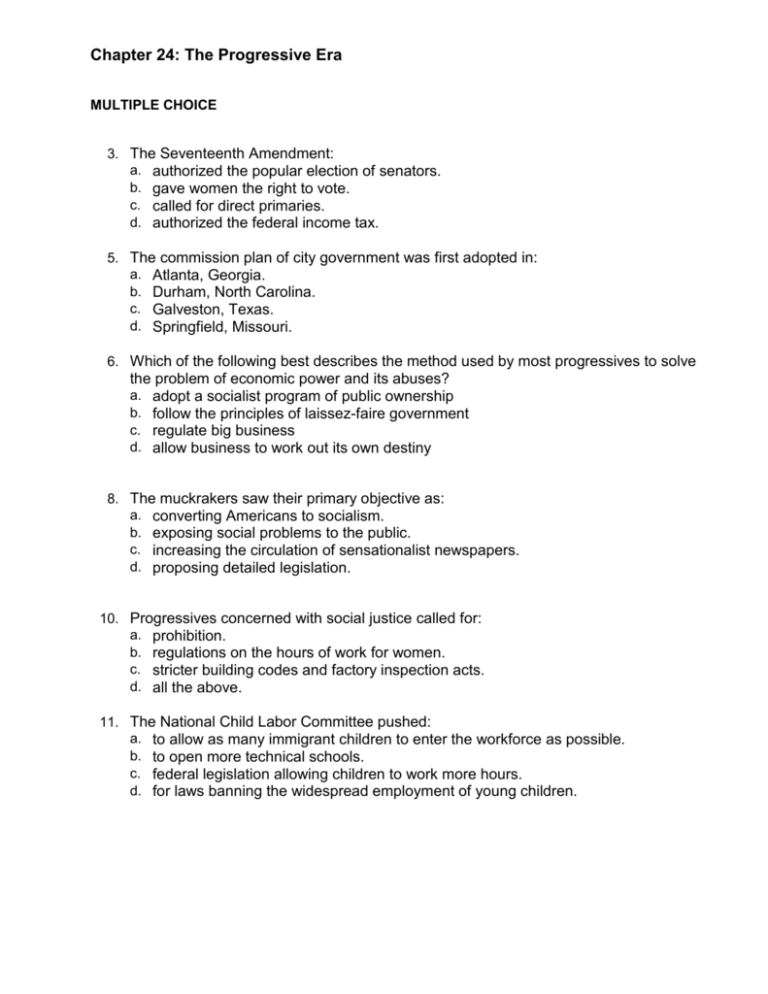
Chapter 24: The Progressive Era MULTIPLE CHOICE 3. The Seventeenth Amendment: a. authorized the popular election of senators. b. gave women the right to vote. c. called for direct primaries. d. authorized the federal income tax. 5. The commission plan of city government was first adopted in: a. Atlanta, Georgia. b. Durham, North Carolina. c. Galveston, Texas. d. Springfield, Missouri. 6. Which of the following best describes the method used by most progressives to solve the problem of economic power and its abuses? a. adopt a socialist program of public ownership b. follow the principles of laissez-faire government c. regulate big business d. allow business to work out its own destiny 8. The muckrakers saw their primary objective as: a. converting Americans to socialism. b. exposing social problems to the public. c. increasing the circulation of sensationalist newspapers. d. proposing detailed legislation. 10. Progressives concerned with social justice called for: a. prohibition. b. regulations on the hours of work for women. c. stricter building codes and factory inspection acts. d. all the above. 11. The National Child Labor Committee pushed: a. to allow as many immigrant children to enter the workforce as possible. b. to open more technical schools. c. federal legislation allowing children to work more hours. d. for laws banning the widespread employment of young children. 12. The Hepburn Act of 1906: a. was the first federal law regulating labor standards. b. authorized the Interstate Commerce Commission to set maximum rates for railroads. c. in effect outlawed the Northern Securities Company. d. is correctly described by all the above statements. 13. The Clayton Antitrust Act: a. was more lenient toward big business than was the Sherman Antitrust Act. b. outlawed price discrimination and “tying” agreements. c. was opposed by labor union leaders. d. was considered by Theodore Roosevelt as the crowning achievement of his administration. 14. In the area of conservation, Theodore Roosevelt: a. believed strongly that natural resources should be preserved but felt that this was a matter for state, not federal, action. b. angered many conservationists by his appointment of Gifford Pinchot, a businessman with no experience in conservation, as secretary of the interior. c. used the Forest Reserve Act to withdraw over 170 million acres of timberland from use. d. vetoed a bill authorizing a National Conservation Commission. 17. At a. b. c. d. the Triangle Shirtwaist Company in 1911: a strike resulted in the intervention of federal troops. Frederick Taylor first applied his scientific management principles. 146 workers died as a result of a fire. the labor force was found to be made up entirely of children. 19. The Ballinger-Pinchot controversy: a. resulted in the immediate dismissal of Secretary of the Interior Richard A. Ballinger for his involvement in corrupt land dealings. b. proved to the public that Taft supported the conservation of America’s resources. c. contributed to the growing rift between Taft and Roosevelt. d. is correctly represented by all the above statements. 20. In a. b. c. d. the 1908 presidential race: Theodore Roosevelt sought reelection. the Democrats once again nominated Bryan. the Socialist vote practically disappeared. prohibition became the major issue. 21. As president, Taft: a. was able to unite a faction-ridden Republican party with his towering personality. b. opposed both the Sixteenth and Seventeenth Amendments. c. brought fewer than one-third the number of antitrust suits prosecuted under Roosevelt. d. in four years withdrew more public lands than Roosevelt had in nearly eight. 23. Woodrow Wilson’s New Freedom platform: a. proposed vigorous antitrust action to break up corporate concentration. b. accepted gigantic corporations as a fact of modern economic life. c. was the creation of a writer named Herbert Croly. d. was the reason Wilson won the 1912 election. 24. Louis D. Brandeis: a. influenced Wilson’s New Freedom. b. led the conservative opposition to federal labor laws. c. was Theodore Roosevelt’s vice presidential running mate in 1912. d. was president of the Tennessee Coal and Iron Company. 25. Woodrow Wilson was: a. a college president. b. the leading Roman Catholic politician at the turn of the century. c. the progressive governor of Oregon. d. influenced mainly by Populist reformers. 27. Which candidate was shot during the 1912 presidential campaign? a. Eugene V. Debs b. Theodore Roosevelt c. William H. Taft d. Woodrow Wilson 28. The election of 1912: a. gave the Democrats effective national power for the first time in over half a century. b. signaled the return of southerners to national and international affairs for the first time since the Civil War. c. gave the Socialist presidential candidate nearly a million votes. d. is correctly described by all the above statements. ANS: D PTS: 1 29. The first Jewish member of the Supreme Court was: a. William Howard Taft. b. Daniel DeLeon. c. Samuel Tilden. d. Louis D. Brandeis. 30. The Underwood-Simmons Tariff: a. raised the average tariff and hence was supported by Wilson. b. raised the average tariff and hence was opposed by Wilson. c. lowered the average tariff and hence was opposed by Wilson. d. lowered the average tariff and hence was supported by Wilson. 32. In a. b. c. d. his first term as president, Wilson: refused to support an amendment for women’s suffrage. allowed the spread of Jim Crow practices in the federal government. withheld support from federal child-labor legislation. did all the above. 34. The cornerstone of Wilson’s antitrust program was: a. the Bureau of Corporations. b. the Federal Trade Commission. c. the Federal Reserve Banks. d. the Underwood-Simmons Tariff. 37. In a. b. c. d. the progressive period: reformers were generally pessimistic about finding solutions to social ills. voter turnout increased. many groups—blacks, the poor, the unorganized—had little influence. All the above statements are true.
